
Named after the 15th century Mossi kingdom of Wagadugu, Ouagadougou is Burkina Faso’s capital city, and by large extent its cultural and economic heart. Formerly the colonial administrative center of the French ruled Republic of Upper Volta, the city is still home to the Mossi tribal chief, aka Mogho Naba, who has been seamlessly reigning over the region for centuries. With its oddly shaped monuments, bustling markets and hectic street scenery, Ouagadougou is a chaotic, yet surprisingly fascinating city to explore.
It is often the case where emerging nations across the world try to consolidate their new national identity by erecting otherworldly monuments, renouncing their colonial past. One such clear instance is the Monument of National Heroes, or Monument des Héros Nationaux, a rocket-shaped tower located in the middle of a gigantic roundabout in the city’s Ouaga 2000 neighborhood, a preplanned quarter for Ouagadougou’s elite and expat community.
While not exactly qualifying as a replica of the Eifel Tower, the monument is deemed by many as the African, the futuristic and even as the coarsely-shaped toy version of the Parisian landmark.
The surrounding dereliction coupled with its faraway location, outside the city’s historic center, somewhat eclipse its supposed monumentality.
Having said that, this outlandish structure is definitely worth a visit, not only because of its cartoonish architecture, but also because its top offers breathtaking panoramic views of the Burkinabe Capital. Despite being built in 2002, the tower’s elevator is defunct. As a result, all visitors must climb an excruciatingly long staircase to reach the observation deck after paying the local guards a small fee. The ones who do make it will be rewarded with a unique vista of the city’s old and new parts.

The Monument of National Heroes and its surrounding roundabout
photography by: Jeff Attaway/ Flickr
Located about 2 kilometers south from the mentioned above tower, at the end of Muammar Gaddafi Boulevard (named after the late Libyan dictator), Kosyam Palace serves as the official residence of Burkina Faso’s president.
Following the former Burkinabe president’s, Blaise Compaoré, decision to host the France-Africa summit, a master plan for a new district was made. The new quarter, Ouaga 2000, was purposely built to accommodate the country’s ruling class, economic elite and foreign community. Its faraway location relative to the city’s historic center was carefully selected as a protective measure against any possible popular uprisings.
The Sudano-Sahelian style presidential complex was completed during the 2000’s, but not without its controversy. The Kosyam hamlet, which the palace is named after, was forcefully evacuated to clear the area for the palace, subsequently leaving all of its residents displaced. Additionally, its immense cost of ten billion CFA francs (equivalent to almost 20 million dollars), in a country where roughly half of the population lives on less than 2 dollars a day, triggered a great deal of resentment.
Nonetheless, the lavish palace and its surrounding gardens are an eye-catching and worthy attraction, an island of verdant tranquility amid a hectic metropolis. Visiting the palace must be booked in advance, either via a local tour agency or alternatively, you can try contacting the staff directly.
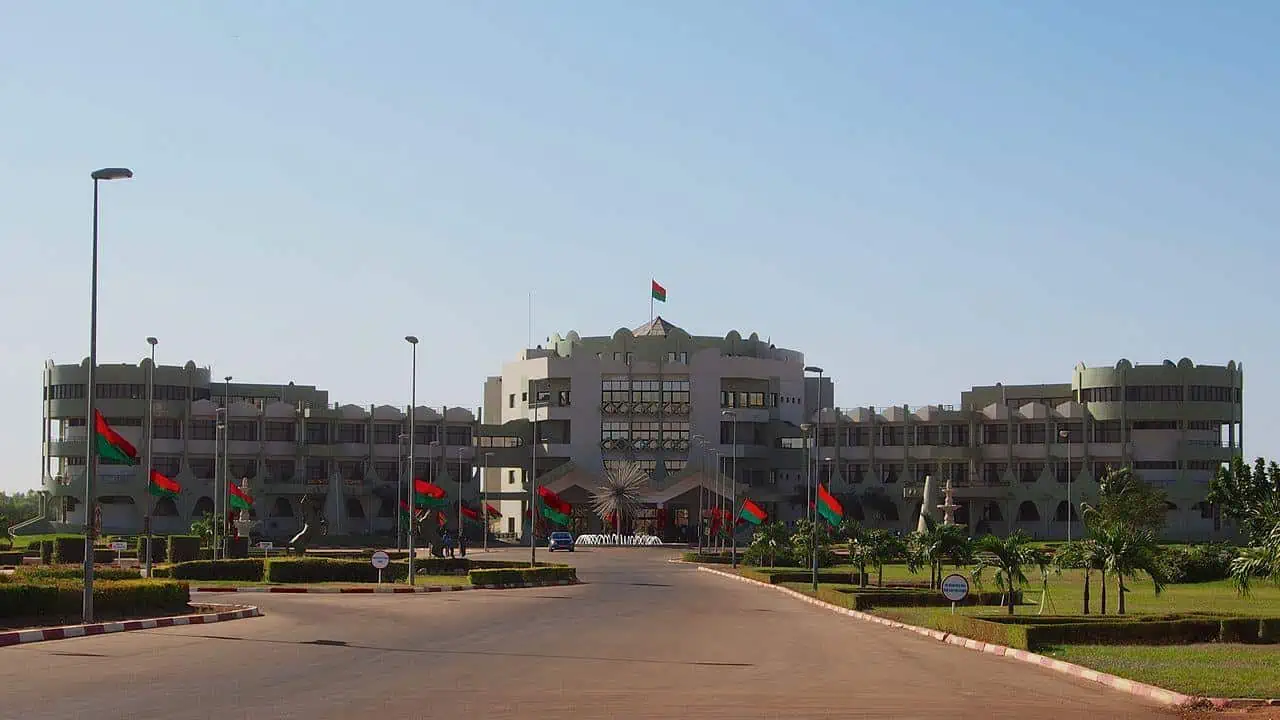
The massive presidential palace adorned with the red and green national flags
photography by: Sputniktilt/ Wikimedia Commons
Burkina Faso is a predominantly a Muslim country, with more than 60 percent of its population adhering to Islam. Originally introduced by merchants coming from the north throughout the 15th century, the Burkinabe Islam is largely shaped by Sufism while also being deeply infused into the local African set of beliefs, in contrary to the purer form of Islam practiced in the Middle East and North Africa.
While sub-Sharan Africa is not always associated with formidable ancient structures, Burkina Faso is renowned for its iconic masterpieces, most notably the Grand Mosque in Bobo-Dioulasso, made of mudbricks and embellished with wooden support beams.
Despite being well-outside the country’s architectural hall of fame, what the Great Mosque of Ouagadougou lacks in glory, it surely makes up for in vibrancy and significance.
The recently renovated mosque is far from being monumental, in fact, its main façade is occupied by several shops, resonating with the city’s chaotic and informal commerce. Its interior is also rather nondescript, devoid of any ornaments, nevertheless, the beautifully woven carpets, densely packed with local men dressed with white boubou, is a mind-boggling sight to behold, especially during Friday prayers.
Take note that women, including tourists, might face refusal when trying to enter the premises. Additionally, it is widely recommended to ask the mosque’s guards for permission to take photos prior to your visit.
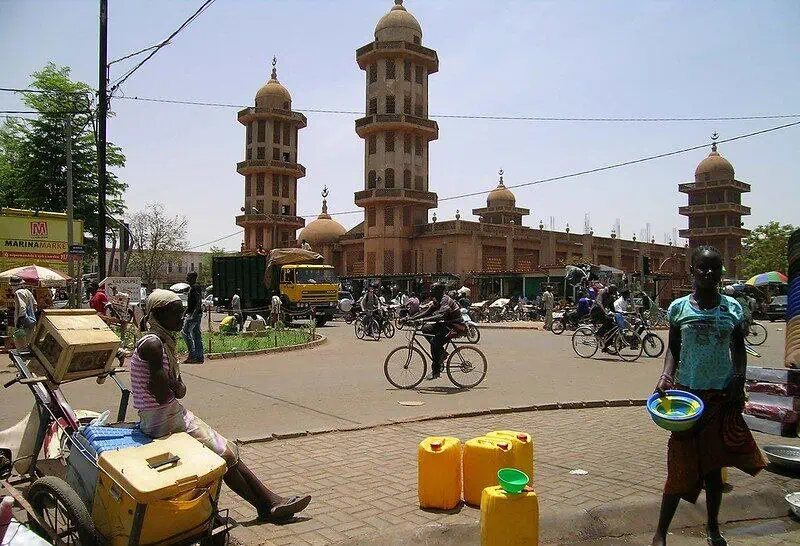
The Great Mosque of Ouagadougou amid the city's informal commercial activity
photography by: Hugues/ Flickr
Given Ouagadougou’s gritty and hectic vibes, it might come as a surprise that the city has one of the largest urban parks in all of Africa. Translated as the “forest of knowledge” in the local Mossi dialect, Bangre-Weoogo spans over 240 hectares, undoubtedly making it the city’s most important green lung.
Also known as La Forêt Classée du Barrage, the park’s cultural significance far predates the colonial era, as the indigenous Mossi tribes considered it for centuries a sacred forest, where initiation ceremonies and other spiritual activities took place. The holy woodland was eventually designated by the French rulers as a park during the 1930’s, paving its way to become both environmental and recreational complex.
The park consists of several distinct zones traversed by a couple of walking trails, one of which is the zoological park (partly a small zoo). Covering an area of 72 hectares, it provides a shelter for 136 species of endemic birds and a host of other animals, including hippotragus, hartebeest, giant land turtles, a flock of flamboyant peacocks and most notably a crocodile infested wetland.
Furthermore, the park’s botanical gardens offer a glimpse of dozens of native plants, accompanied by mystical wooden sculptures that reflect the forest’s ancient spiritual role.
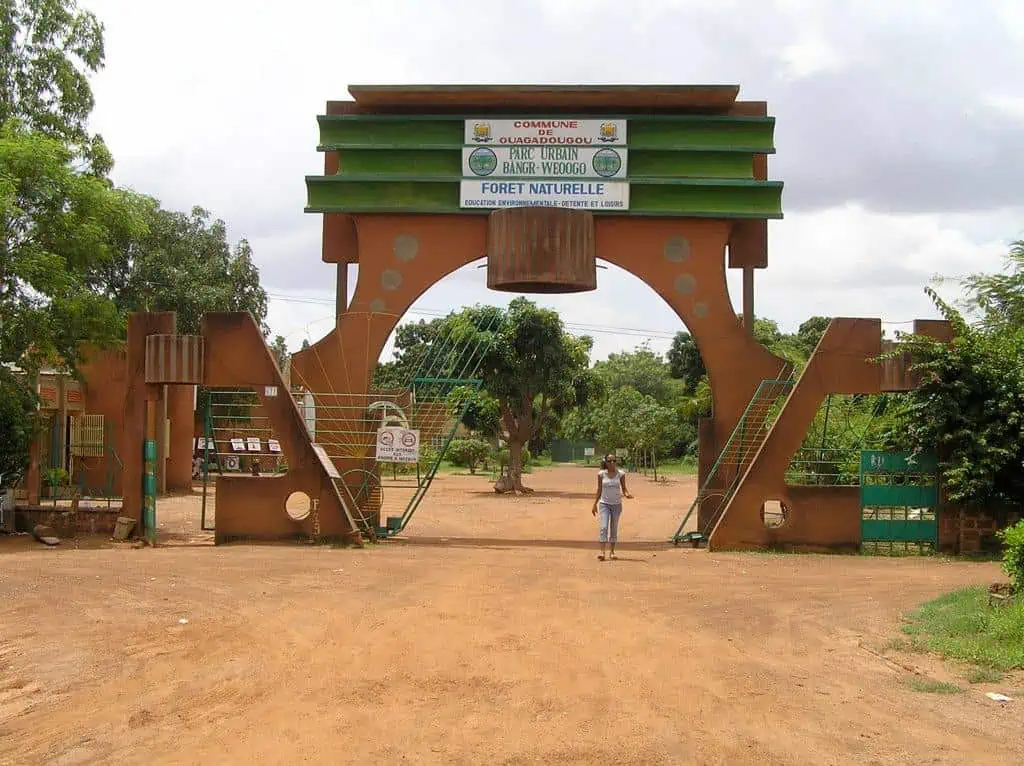
The main gate of Parc Bangr Weogo
photography by: Jeff Attaway/ Wikimedia Commons
Central Ouagadougou is home to countless unusual buildings that were built in Burkina Faso’s post-independence era, yet none of them is as emblematic of the city as Maison du Peuple, designed by the French architect Foblé.
Built in 1965 as the headquarters of the country’s ruling party, the UDV (Union Démocratique Voltaïque), it was named Maison du Parti after its political owners. Following several uprisings and a military coup, the building was renamed accordingly, the People’s House.
While its façade is embellished with a hodgepodge of local ornaments, the building is best-known for its series of triangular spires, functioning as skylights that illuminate the interior. Interestingly, it comes as an inspiration to the widespread use of conical roofs in the vernacular Mossi architecture.
Throughout the last decades Maison du Peuple fell into a state of disrepair, nevertheless, this once lavish building still serves as a major venue in Ouagadougou. With a capacity of more than 3,000 people, many concerts, exhibitions, festivals and all sorts of public events take place within its premises, that besides a spacious hall, also has several pavilions, eateries, courts and even a radio station.
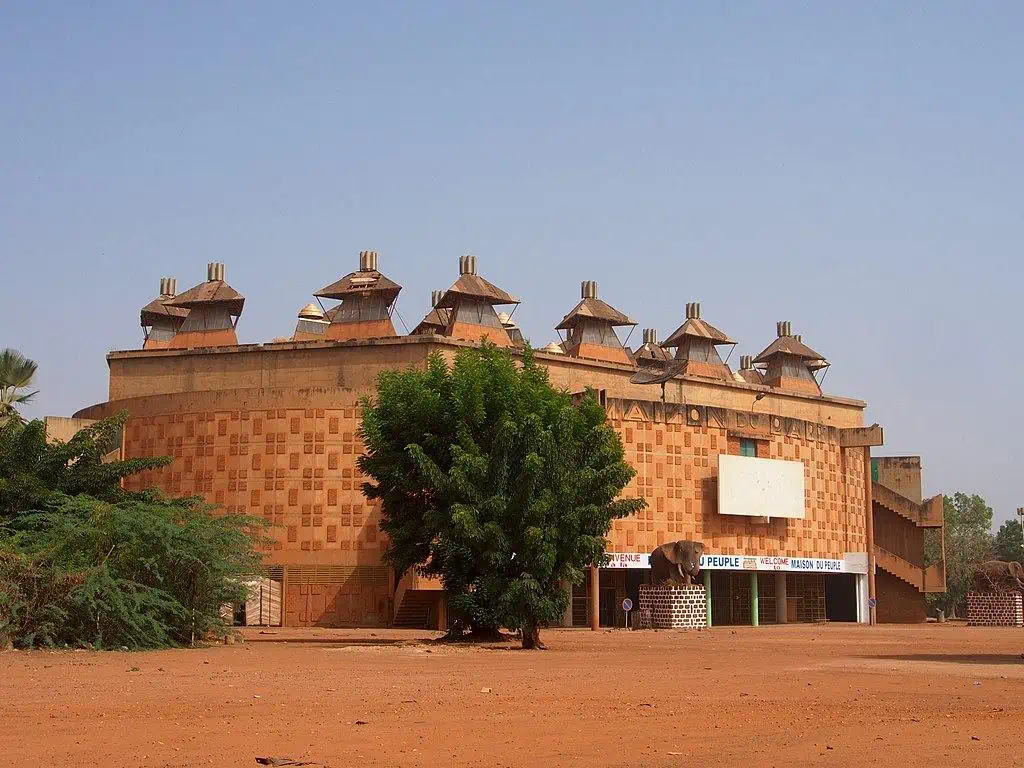
Maison du Peuple and its iconic conical skylights
photography by: Sputniktilt/ Wikimedia Commons
As you’ve probably realized by now, the Burkinabe capital has the proclivity to absorb both Western and African influences and fuse them into a brand-new thing. There is probably no better example for those local Frankensteinian hybrids than the quaint cathedral of Ouagadougou, also known as the Cathedral of the Immaculate Conception.
Inaugurated in 1936 by the initiative of Joanny Thévenoud, a well-renowned French missionary who promoted economic and political progress throughout the then French colony, this religious building serves as the cathedral of the Archdiocese of Ouagadougou, the main Catholic authority in the country.
Completely built of adobe, the cathedral might be inspired by a typical Romanesque style when it comes to its façade and ornaments, yet the locally manufactured orange-brownish mudbricks cannot be mistaken with a Parisian church. Likewise, its interior lacks any kind of the usual grandeur, and at the same time is comprised of three naves lit by dozens of oculi and semi-circular openings, modeled after cathedrals in Europe.
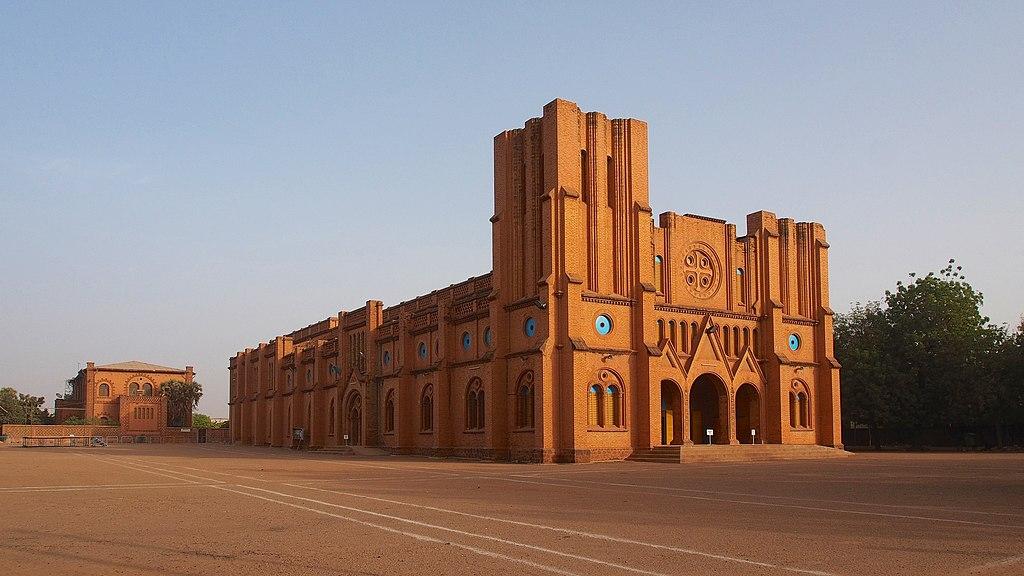
The Cathedral of Ouagadougou, primarily made of mudbricks
photography by: Sputniktilt/ Wikimedia Commons
It’s utterly difficult to overstate the immense level of chaos and hecticness in urban markets throughout Africa, and still, Ouagadougou’s central market seems to be in a league of its own, insanely crowded and dominated by strong odors wafting through its maze.
Locally known as Rood Woko, the grand market is sandwiched between Maurice Yameogo Avenue and Du Travail Street, acting as the beating heart of the city. In 2003, the market was completely burned down and reopened six years later in a modern and larger building. Interestingly, the temporary closure of the market forced thousands of vendors to relocate their operations elsewhere, inundating the streets of Ouagadougou with informal and makeshift commerce that is still very much present to these days.
The market provides a very intense experience of West African culture, most renowned for its clothing section that offers a plethora of traditional and colorful garments, shoes and fabrics. Apart from the bustling vegetables and fruits department, several stands sell different kinds of bushmeat and local street food.
All visitors who enter the terra cotta colored mega-structure are greeted by a whimsical statue of a long-necked African figure whose belly is hollow. This quaint sculpture however is not an indication of an ample souvenir section, which in that case is outshined by the far better Village Artisanal de Ouagadougou.
Take note that haggling is a common practice throughout the market, so make sure you start bargaining from as low as 20% of the original price. Additionally, be aware of pickpocketing and keep all your valuables in a safe place before your visit.
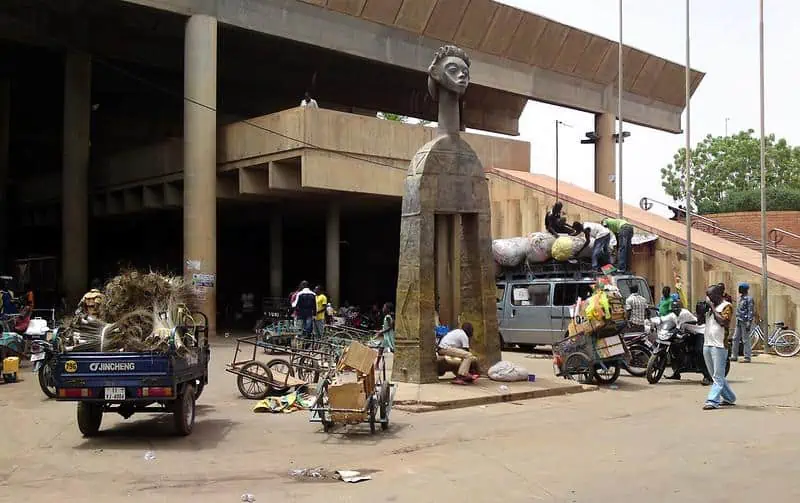
The Grand Market's main entrance, marked by the unusual sculpture of a long-necked figure
photography by: Maarten van der Bent/ Flickr
As the name suggests, Place de la Révolution (the Revolution Square) was built in 1984 following a socialist revolution led by the late Thomas Sankara, who became the president of Burkina Faso via a coup d’état. Sankara was vastly revered as a national hero for promoting women rights and implementing a series of progressive policies that benefited the lowest echelons of society.
Designed by Mansudae Art Studio, a North Korean firm that erects communist-style monuments all over the world, Place de la Révolution seems as if it was teleported directly from Pyongyang as any unsuspecting passerby would probably testify. Besides its monumental scale, its centerpiece, a marble cenotaph topped by a torch-shaped sculpture and covered by a large mural that depicts poor peasants, is unmistakably reminiscent of the Juche Tower in Pyongyang.
Three years after he rose to power, Sankara was assassinated as part of another coup organized by his lifetime friend and colleague, Blaise Compaoré, who subsequently inherited the presidency and served in this position for more than 2 decades. Ironically, Compaoré was ousted in 2014, following a popular uprising that was fueled by mass-demonstrations that took place in the Sankara-era Revolution Square.
Just a minute away from the square lies another symbol of the city, the Rond Point des Cineastes is a busy roundabout with a colorful hoop stack shaped statue at its center. The futuristic design of the 1987’s monument is a gesture to African filmmakers, as all of its shapes are abstract representations of film reels and camera lenses.
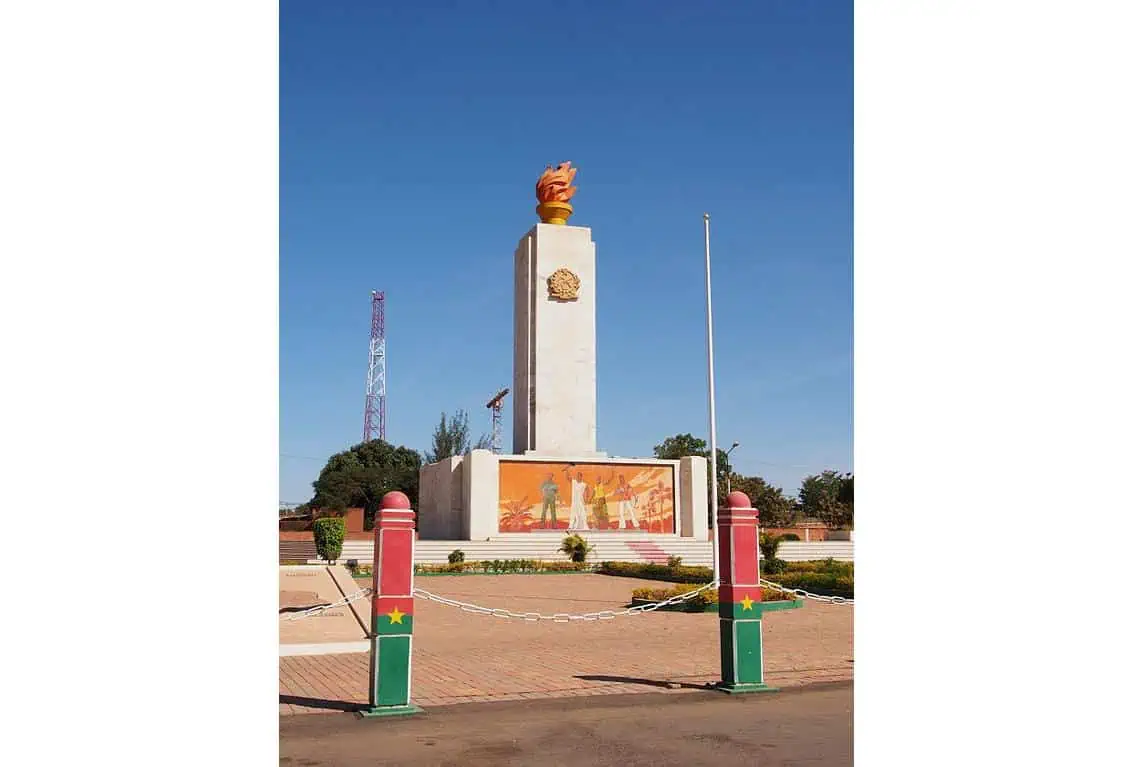
The North Korean style monument in the center of Place de la Révolution
photography by: Sputniktilt/ Wikimedia Commons
While Burkina Faso is a relatively new country, gaining independence from its French Colonial Rulers in 1960, this African nation has retained much of its pre-colonial customs, including a tribal entity that has been in existence since at least the 12th century.
The ancient Mossi Kingdom that predated both the French colony of Upper Volta and the current modern state has run parallelly to the official government even when it no longer had any real political authority. In fact, Moro Naba, the Mossi Chief who is equivalent to a monarch, has been in power continuously since 1132, when as of 2021 the incumbent and 37th Moro-Naba is Naba Baongo II.
Nestled in the heart of Ouagadougou is the Moro Naba Palace which unsurprisingly serves as the seat of the Moro Naba. The spacious royal complex consists of two sport courts, a sparse grove and a gated hamlet centered around the Mossi Palace.
Every Friday at 7AM, the palace hosts a 15-minute-long ceremony where the Moro Naba arrives on a horse while being dressed in red garment, as if he was about to wage a war. The entire Mossi elite, that is present during the ritual, then pledges its alliance to the Moro Naba, who returns shortly after, wearing a white boubou, a symbol of peace.
This centuries old tradition allegedly derives from a past event where the Mossi King was dissuaded by his fellow chiefs from attacking a neighboring kingdom.
Tourists are welcomed into the ceremony as long as they refrain from taking photos and videos.

The Moro Naba surrounded by his senior Mossi chiefs during the 1930's
photography by: Bildarchiv online/ Wikimedia Commons
Perhaps the region’s most prominent form of art, sculptures are far more than just cheap knick-knacks for tourists, as some of which are the best-preserved relics of ancient African kingdoms, given their lack of written language and durable architecture.
Tucked away roughly 30 kilometers northeast of Ouagadougou, the open-air museum in Laongo is a modern testament of the sheer significance of sculptures for the Burkinabe people. Home to more than 2,000 sculptures, beautifully carved from local granite rocks, the site spans over 100 hectares of thicket, densely dotted with the etched artworks.
Founded in 1989 by the Burkinabe sculptor Siriki Ky, the site annually hosts the Laongo Sculpture Symposium, where artists from across Africa and the world gather to create their own personal sculpted rock that will ultimately be part of this unusual cluster of sculptures.
Whereas some of the sculptures might look like a large-scale version of typical African souvenirs, others are exceedingly surreal, and even creepy, particularly the facial figure of an angry creature and the head of a decapitated donkey. Another piece of art that is immensely popular among visitors is a statue depicting the glorious former president, Thomas Sankara, a tribute for his legacy that is still referred by many as the country’s golden age.

Two of the thousands of weirdly shaped sculptures of Laongo
photography by: Kirsten-h/ Wikimedia Commons